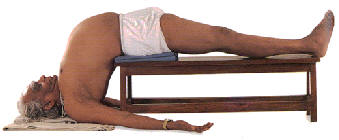有許多學生提及在練習橋式體位法時,膝關節處疼痛。是甚麼原因造成?如何修正此體位法,可使膝關節處的壓力降低?-Charry
A:
Read Maty Ezraty's response:
Dear Charry,
Making a good diagnosis is crucial to figuring out a remedy or a remedial approach. When students experience pain in the knees, you need to know which part of the knee is hurting: the front, the inside, the outside, or the back. Each of the different areas indicates a different problem.
做出一個正確的診斷對於找出一種適宜的矯正或治療方案至關重要。當學生體驗到膝關節處疼痛時,你需要瞭解是什麼部位受到了損傷:前側,內側,外側。後側。不同的區域的疼痛,顯示著不同的問題。
Also keep in mind that all injuries are different, so it is necessary to have an open mind and be willing to experiment. Remedial work often requires some trial and error, as well as feedback from the student.
另外,要記住,所有的損傷都會有所不同,所以必需有一種開放的心態,樂意去進行嘗試。矯正與治療工作經常需要一些試驗,會出現一些差錯,也需要從學生那裏獲得回饋的資訊。
Here are some helpful questions to ask:
這裏需要詢問一些問題:
Where exactly is the pain? Does the student feel the pain while in the pose, or while coming in and out of it? How long have they had this pain? Does the pain last after class? Is the pain sharp or dull? Did the pain happen as a result of yoga or something else?
是什麼具體部位疼痛?學生感覺疼痛是在體式練習中,或者是進入也結束體式時?這種疼痛持續多長時間?疼痛持續到課後嗎?疼痛是刺痛還是隱隱作痛?疼痛是由於瑜伽還是其他的原因引起?Pain in the back of the knees is generally related to forward bending. I would not expect your students to be complaining of that in this pose.
膝關節後側的疼痛通常和向前彎屈相關。我不希望你的學生在這個體式中抱怨。
The most common complaint in this pose is pain in the front of the knee. In bent-leg poses, it is important to stack the knees directly over the heels and to have the weight in the heels rather then in the ball of the foot. Take time to teach the setup for each pose you teach. The problem often lies in the foundation, or root, of the pose. The foundation must be correct in order to build a solid, healthy pose.
在這個體式練習中,最常見的抱怨是膝關節前側的疼痛。在屈腿的體式中,重要的是保持膝關節在腳跟的正上方,讓重量落在腳跟位置而不是腳前掌處。要花費時間在你所教授的每一個體式的調整上。問題往往潛藏在體式的基礎上,或者是體式的根基上。其基礎須正確的想辦法去建立純粹健康的体位法。


In setting up for Setu Bandha Sarvangasana, most students place their heels too close to their sitting bone. This will only work for students with open groins and an open backbend. For most students, this setup will cause the knees to go past the ankles, putting pressure on the front of the knees. Also, in this pose, the knees often go forward relative to the heels, causing pressure at the front of the knee. This frequently happens if the students are trying to hold their heels with their hands before being flexible enough to do so correctly.
在開始做橋式(Setu Bandha Sarvangasana)的練習時,大多數學生把兩腳的後跟過分地靠近坐骨。這只適合於腹股溝已經打開和向後彎曲能力好的學員。對於大多數學生來說,這種調整會使得膝關節超過腳踝,把壓力施加在膝關節的前側。並且,在這個體式中,在柔韌性沒有達到適宜的程度時,如果學生們嘗試著用雙手抓住他們的腳踝,經常會出現膝關節與腳後跟一起前傾,引起膝關節前側產生壓力的問題。不正確的位置帶來膝關節前側的很大壓力。
Start most students with the heels two or three inches forward relative to their sitting bone, so that once they are up, the knees are over the ankles. In poses where the leg is bent, the weight needs to be in the heels to protect the knees. The action of moving the shin toward the calf and the calf down into the heel is a good one to help relieve pain in the front of the knee.
開始時,大多數學生兩腳後跟放置在坐骨前側兩至三英寸的距離,這樣,當他們抬起身體時,膝關節在踝關節的正上方。在體式中,腿部是彎曲的,重量必需落在後跟處以保護膝關節。脛骨朝著腓腸肌方向移動,腓腸肌向下朝著腳後跟移動,這是一種非常好的方式,有助於緩解膝關節前側的疼痛。
If the pain is on the inside or the outside of the knees, it can be due either to incorrect placement of the feet, incorrect tracking of the knees, or overworking the knees. Again, start by looking at the foundation of the pose. Start with the feet at least two inches forward of the sitting bone, and make sure the feet are hip-width apart and parallel. If the feet are too close together or too far apart, too much pressure can fall on the knees. It is always good to check and make sure that your student knows how to evenly ground all four corners of their feet.
如果疼痛出現在膝關節內側和外側,可能是源於兩腳的位置不正確,引起膝關節的位置不當,或者是膝關節的過度工作。再一次關注體式開始時的基礎位置。兩腳離開坐骨至少兩英寸,確保兩腳分開與髖等寬,並且彼此平行。如果兩腳分開過大或過小,過多的壓力會落在兩膝之上。最好是經常進行檢查,確信你的學生知道如何讓他們腳部的四個邊角均衡地著地。
Incorrect tracking of the knees can also put pressure on them. The knees should point over the second toe. If the student is tracking the knees in or out too much, this can cause pressure on the inside or outside of the knee.
膝關節不正確移動也會增加它們所承受的壓力,膝關節應該正對第二腳趾的上方。如果學生移動膝關節過多地內收或外展,這將會引起膝關節內側或外側過多的壓力。
The inside of the knee is the final most common area of pain in this pose. It can occur when a student is using the knees to rotate the thighs, rather then using the upper thigh. Therefore, do not teach students to rotate the knees in, but rather to keep the knees hip-width apart and parallel. The proper rotation of the legs in backbending occurs in the upper thigh, not the knees.
膝關節內側是這個體式所引起的疼痛最終最常見區域。它會出現在學生用膝關節來轉動大腿而不是大腿的根部。因此,不要教學生向內轉動膝關節,而是要保持兩膝與髖同寬而且平行。向後彎曲中兩腿適度的旋轉要從大腿的上部(根部)開始,而不是從膝關節處開始。
Maty Ezraty has been teaching and practicing yoga since 1985, and she founded the Yoga Works schools in Santa Monica, California. Since the sale of the school in 2003, she has lived in Hawaii with her husband, Chuck Miller. Both senior Ashtanga teachers, they lead workshops, teacher trainings, and retreats worldwide. For more information, visit http://www.chuckandmaty.com/.
 瑪蒂·艾茲拉蒂(Maty Ezraty)
瑪蒂·艾茲拉蒂(Maty Ezraty)從1985年起練習和教授瑜伽,她1987年在加里福尼亞聖塔蒙尼卡建立了瑜伽學校,後來和丈夫查克·米勒在洛杉磯建立了瑜伽學校,是美國最大的和最成功的工作室之一。工作室主要教授阿斯湯伽(Ashtanga)、艾揚嘎瑜伽(Iyengar)和維尼瑜伽(Viniyoga)。2003年她出售了學校,與丈夫Chuck Miller居住在夏威夷。

他們都是阿斯湯伽資深教師,他們在世界上舉辦講座,進行教師培訓,舉辦瑜伽靜修。更多的資訊,可以流覽他們的網站: http://www.chuckandmaty.com./
---------------------------------------------------
---------------------------------------------------
這篇文章,是《yoga journal》上的文章,BEANIE曾經翻譯過,一日無聊之時,重新譯了下子,作為一種溫習英語的練習。
http://www.yogajournal.com/practice/2180_1.cfm
http://www.yogajournal.com/practice/2180_2.cfm
文中橋式照片來源於網路,僅供大家學習參考之用!
http://www.yogajournal.com/practice/2180_2.cfm
文中橋式照片來源於網路,僅供大家學習參考之用!
NOTE:
1.轉載自YOGIC
1.轉載自YOGIC
英文及部分譯文MOLI修正及置入,供讀者比照參考
2.從2007/04月我的右膝關節疼痛至今才緩解
其膝關節疼痛亦可能與瑜珈無關
另在瑜珈聖經曾提及Ashtanga Yoga練習過程時膝關節易疼痛
轉載本文給大家參考
在瑜珈體位法精進練習時,請放下好勝比較心
多ㄧ點心思放在自己身體的回饋
走的長遠較完成高難度體位法炫耀
應更重要
moli
沒有留言:
張貼留言